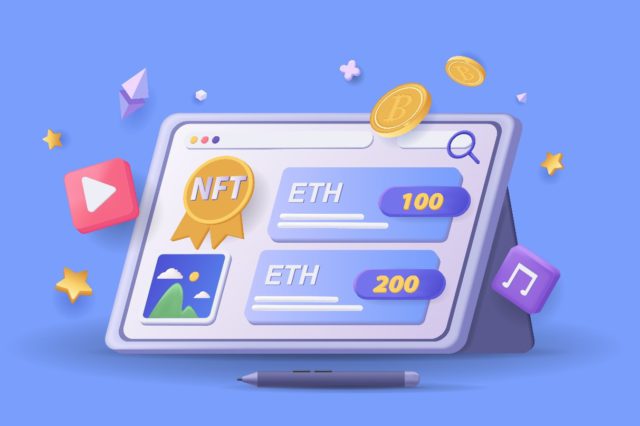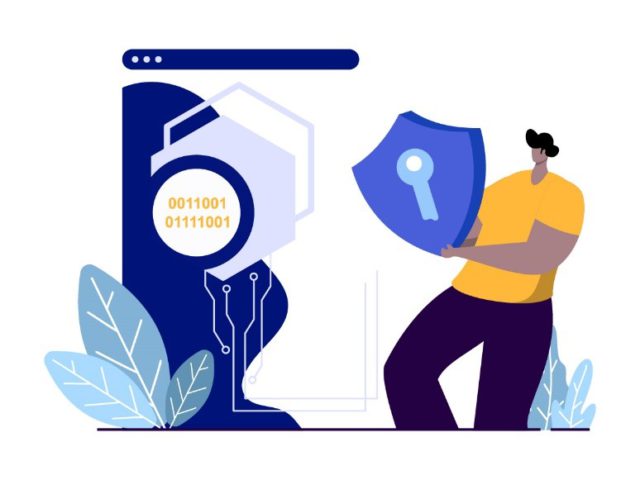NFTs are the digital assets which are proving to be the initial steps to the digital path of creating Web 3.0. Completely based on blockchain, NFTs are proving to be the emerging trend. NFT transactions have seen record growth in the past two years and now big players are entering the space by introducing NFTs for their own products.
What are NFT Marketplaces?
NFTs have a specific monetary worth to their owners despite their intangibility and nonfungibility. Otherwise, there would be no commercial motive to promote NFTs. So, where you can try to trade of NFTs? How would you provide those goods to users? NFTs cannot be traded on conventional cryptocurrency exchanges because they are separate assets. At this time an NFT marketplace development service comes in use.
NFT marketplaces are a form of decentralized applications. They offer a platform for NFT holders to store and sell their digital assets. As per the recent findings, the number of NFT marketplaces has exploded in the past few years. Some provide specialized tokens, while others are open to anybody interested in trading NFTs. How to come to know that which option is the best suitable among a plethora of options? In the NFT market, there are three significant distinctions, a general platform, a specialist platform, or just a collection of galleries. Now, it’s up to you to decide which one you want to choose for yourself and your business.

NFT Marketplace Development
Unlike digital currencies there are many features of NFTs that we have to keep in mind while developing an NFT marketplace on blockchain. These features are the distinctive feathers users follow while minting NFTs. Some of these features are:
- Indivisibility: NFT tokens cannot be divided into small denominations.
- Authenticity: Every non-fungible token has a unique owner who can be easily identified.
- Non-interoperability: Because NFTs aren’t all created equal, it’s difficult to trade them for popular cryptocurrencies like BTC and ETH.
- Tradability: On a variety of cryptocurrency exchanges, NFT tokens can be purchased. The upgraded trading platforms benefit NFT owners because the options are nearly endless.
- Interaction with a number of different blockchain ecosystems: A couple of standards, ERC 1155 and 721, can be used to create NFTs for digital collectibles.
- Liquidity: Non-stop trading is possible with NFTs. therefore, their liquidity is high. A wide spectrum of clients may be interested in purchasing or selling NFT tokens.
- Programmability: Many people associate an NFT platform with complex mechanics such as forging, crafting, and producing. This niche suggests numerous of possibilities and variations. We can say NFTs are the fantastic place to show creativity.
- Scarcity: Programmers can impose a variety of specific characteristics that cannot be changed after they have been launched.
We shall show that developing NFT marketplaces is a lucrative business. The market for NFTs expanded to $41 billion in 2021, almost matching the total value of the global fine art market.
Making money in this manner is not difficult. Here are some examples:
- Jack Dorsey’s first tweet, which he sold for about three million dollars, is another fantastic example of a successful non-fungible coin.
- NFT tokens in gaming and art were valued millions of dollars in 2021 and continues to do so in 2022.
- NBA’s Top Shots, a trading card system (TCS), is valued about $230 million if we’re talking about the most successful and expensive examples.
- Kings of Leon is another great example. In 2021, band members were able to sell their tracks for two million dollars.
- CryptoPunk #6965, which sold for 1.54 million dollars in 2021, is another option.
- Taco Bell and other well-known brands have created NFTs by recommending digital items.
These figures illustrate that the rise of the NFT marketplace makes sense. While market capitalization (also known as a market cap) is increasing, more and more globally recognised brands are following suit.
User Flow on a NFT Marketplace
The user flow looks to be the same for NFT sites. Visitors to your website should register by providing all required information. To save all of their currencies in one place, they need either create a crypto wallet or link an existing one.

The creation of NFTs is the next step. Those who have completed the registration process are required to submit digital assets that represent their work. They may assemble whole collections and sell artworks at a given price, or they may set up a bidding system in which the buyer who makes the best and final offer wins the piece.
There will be no products on the platform until they have been reviewed and approved. Moderation is necessary. Once the system enables it, customers will see NFTs available for sale or bidding. The auction starts now. You can choose the coin you want to trade. When everything is sold, all parties are notified. Finally, the service records all transactions and movement of items.
A common user flow looks somewhat like this. You can use this method to guide yourself through the entire NFT marketplace development process.
Security Risks for NFT Marketplace
Hacks and exploits in smart contracts have been known to attack NFT marketplaces. Opensea was recently compromised, allowing the hacker to make off with $1 million in NFTs. There are also fake markets. Simply explained, these are phishing schemes that trick users into connecting their wallets and entering their private keys, allowing them to steal both information and digital assets from the wallet.

Identity Frauds
Malicious actors can commit identity fraud if they acquire access to a user’s cryptocurrency wallet through malware or phishing. When hackers acquire access to a marketplace’s wallet, they are recognised as the owner of the wallet, and they can now send assets to other addresses and new marketplaces.
Smart Contract Risks
Smart contracts’ integration in NFTs has offered both benefits and risks. The method NFTs are circulated between parties and traded on marketplaces is defined by smart contracts. The quality of the code is critical because a misstep could result in an undesirable outcome, such as an NFT seller losing their assets. Furthermore, smart contract security must be of high quality because even tiny flaws can be used by hackers to steal assets. According to Chainalysis Crime Report 2022, hacks on platforms and marketplaces reached an all-time high in 2021, with $14 billion in digital assets lost to hostile operations.
Rug Pulls
Rug pulls have become rather prevalent in the NFT world. A rug pull usually entails a new enterprise that promotes an NFT collection, spends a lot of time promoting it, and tries to attract as many investors as possible. By the time the project is intended to be live, the proprietors had cut off all communication and taken the money from the investors. Rug pulls have cost people millions of dollars, but there are some warning signs to watch for to prevent becoming a victim:
- The project arose seemingly out of nowhere.
- The members of the project team have chosen to remain nameless.
- A mixer, such as TornadoCash, has sponsored the project.
- There is a lack of community interaction and no regular project improvement.
- There are no audit certificates for this project.
- Liquidity is now available.
- One wallet holds all of the liquidity.
- Rug Doctor and Token Sniffer are two anti-rug pull programmes.
NFT Hacks
Because the image isn’t saved on the blockchain, an NFT can’t be hacked. Instead, it stores an address to where the actual image can be accessed, which is usually IPFS. Most hackers gain access to NFTs through inadequate security measures implemented by projects or by accessing a user’s crypto wallet due to a lack of 2-factor authentication and other security precautions. According to ABIR Networks, a leader in blockchain cybersecurity, reentrancy attacks are one of the key NFT security vulnerabilities associated to the exploitation of smart contract.

How To Secure Your NFT Marketplace
Because NFTs are stored in the user’s crypto wallet, the user is responsible for much of the security. When possible, users should use multi-factor authentication. Because the bulk of hacks and malware target hot wallets, users with important long-term assets may benefit from putting them in a cold wallet that is not vulnerable to internet security issues.
There are other dangers, such as internet frauds and malware. Users should keep their computer security up to date, and a VPN isn’t a bad idea either. When a user visits and downloads from unprotected websites, they expose themselves to malware and other viruses that can steal personal and financial information. Users should always use official sources of information when using social media and communication groups, and not download apps shared by unknown persons on Discord or Telegram. Crypto cyber security businesses like ABIR Networks also offer a variety of security solutions to defend and prevent cyber attacks on your NFT Marketplace.

It’s also crucial to think about the security of the blockchain on which the NFTs are kept. Users can check if a blockchain is secure by looking at if it has been audited by a renowned cybersecurity firm such as PeckShield, Hacken, Utrust, Certik, ABIR Networks and others. Users can also examine whether a blockchain’s smart contracts and NFT token have been audited.
A general checklist for defending yourself against cyberattacks is as follows:
- Select a safe wallet.
- Make your password difficult to guess.
- Two-factor authentication should be enabled.
- Save your recovery phrase somewhere safe.
- Regularly back up your wallet.
- Regularly update your software.
- Make use of a safe internet connection.
Conclusion
Although both NFTs and cryptocurrencies are considered digital assets, there are several distinct characteristics. The primary distinction is that NFTs cannot be swapped or replaced, making trading difficult. They can be tokenized in the same way as cryptocurrency tokens can, although not to the same extent. NFTs have security vulnerabilities as well, however they can be avoided if the user takes an active role in their wallet’s security and follows best practises. NFTs may yet see a lot of growth and many new inventive applications in the crypto field due to their expanding popularity.


